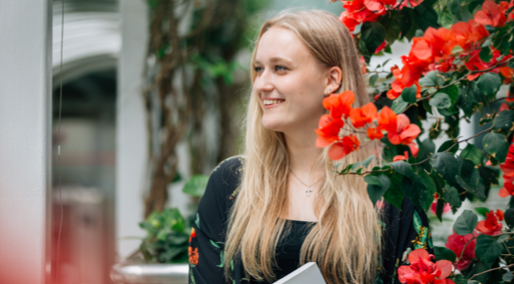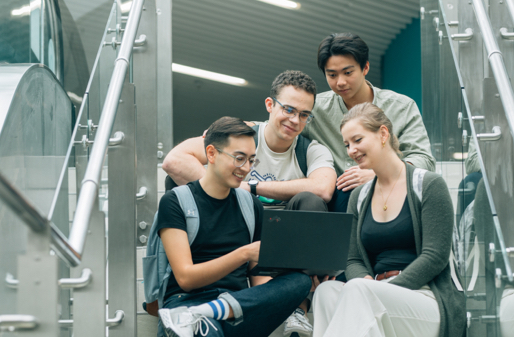Karina Duisenova
As a die-hard fan of film and TV, I cannot overestimate the influence American movies have on our perception of the world. From a very young age, many of us watched shows made by the US, such as Friends, Gravity Falls, Brooklyn 99, The Office, Gumball, Community, and so many other series that are situated in the US and show the American lifestyle. I was curious to travel to the land where all these iconic movies and shows were made to explore the culture that many of us have only seen on TV. As such, I decided to apply for a semester abroad in the US for this and many other reasons to explore the local culture, education, and community. Soon, I received the offer to study with American University in Washington DC for my semester abroad. I will share what it is like to travel and study in the US for the first time and give some tips for students who plan to travel abroad in the future.
Before my departure to the US, I had to register for classes that were approved for credit transfer, get a visa suitable for exchange students, and find housing for the period of stay. My fall semester was engulfed in preparation for a semester abroad, but after getting all the necessary documents I was ready to depart. It was also important to consider the COVID-19 restrictions that were still partially in force, so I recommend future applicants to look up any flight restrictions beforehand as that might jeopardize your trip.
Campus Life
Student Residence
At first, my only option was to reside off-campus in a rented apartment near the university because there were no free rooms in the dorm. This was slightly tricky because to find a good apartment I had to search for a suitable location, a less pricey but comfortable space, good roommate(s) to split the cost, and public transport nearby. Luckily, after a few weeks, I received an email explaining that there were a few free beds at the on-campus housing and I could apply to get one. Living in a student dormitory when studying abroad has its benefits. First and most important – it is a great way to make friends in a new country and new community! My roommates were extremely helpful during my first two weeks of arrival, sharing essentials that I had not bought yet and showing me around the campus. Dorm life makes immersion in a new culture and society much more manageable, so I would definitely recommend it. As a bonus, depending on the country, state, or city, living in student housing might be cheaper and closer to campus.
Dining
Colleges in the US have meal plans that are often mandatory for first- and second-year residential students. These plans vary from college to college, but generally, they include a certain number of meals within a semester. Different meal plans account for a varying number of meals per week, ranging from 7 to 21 meals a week. Students pay for the plan at the beginning of each semester and swipe their student cards in dining facilities to get their meals. Getting a 100-meal plan for a semester was convenient for me because sometimes I like to cook for myself, and it is also much cheaper to do so. At my university, there is a main dining room and a dozen smaller kiosks and cafes where students can get a variety of meals and snacks, from bagels to poke bowls. My favourite place is Halal Shack, which has healthy nutritious meals, as well as the main dining room, which has a huge selection of food from salads to desserts all for one swipe of your card.
Student-led Organizations
Universities in the US are well known for their student clubs, societies, and organizations that receive generous funding and do weekly activities. In my host institution, there are more than 150 student-led organizations, and I have got to know some of them during an Involvement Fair. I often visit events hosted by organizations that I am not part of because they welcome everyone – even those who do not have an affinity with minority groups that lead the organizations. I visited a speed-friending activity and a boba night hosted by an Asian-American society. I also had a lovely chat in Russian during a tea party for students from Slavic countries. I enjoyed a heritage tour around the capital organized by the African American society, and danced salsa with a lively Latino community. I have also joined a local television and broadcasting club as well as an art club which host weekly activities. I definitely recommend future outbound exchange students to engage with all sorts of clubs whenever possible and learn more about local communities and their diversity.
Academics
To me, studying in the US has several similarities and differences from my studies back in CityU. The main difference to me was the approach to teaching. At CityU, my course workload was mainly comprised of projects and continuous assignments, and I had a more hands-on, practical study experience. Institutions in the US value textbooks as a base material for lectures, so we have a lot of weekly homework and mandatory reading for classroom discussions. My experience is subjective to my major (Creative Media) classes, university, and exchange location. Therefore, my observations might differ from those of other exchange students. I believe it is important to embrace a different approach to learning during an exchange study and try to make use of it in self-improvement, as this is an essential part of studying abroad.
Washington DC
Washington DC, the capital of the US, is home to a diverse community. There are international visitors from around the world and American citizens from nearby states who work and study in this city. People here celebrate important traditions of their culture and eagerly show them to curious foreigners. People from different parts of the world celebrate their cultures and welcome those who are interested. There is always a festival to participate in, an educational place to visit, live music to listen to, and people to meet.
Events, Festivals, and Holidays
Soon after my arrival, I was greeted with a hectic Lunar New Year preparation, which took me by surprise. I did not expect a Chinese cultural celebration to be held in a different country with such vigour on display by the locals. There were events in the university organized by the Asian-American society, such as the Lunar New Year dinner with dumplings and fried noodles, Penyou speed-friending, and basic mandarin learning meet-ups. Outside campus, there were also different celebrations and activities and attracted different communities from all over DC. The main event of the celebration was the Lunar New Year Parade in the local Chinatown, which featured representatives of all Asian embassies and Asian-affiliated institutions who staged performances with drums and dragon dances.
Heritage and History Month is now a major part of US culture, and was only implemented a few years ago. This tradition basically celebrates diverse communities each month of the year. For instance, February is African American History Month and March is Women’s History Month. Throughout this past February, there was a plethora of events and workshops around the city to celebrate the long-lasting fight of African American people for their rights. I even had the opportunity to go on a student-organized African American heritage tour around the capital. We visited the Lincoln Memorial, the Emancipation Monument, the African American Civil War Memorial, the Martin Luther King, Jr. Memorial, and the National Museum of African American History and Culture as our final destination.
Mardi Gras is a festival I had never heard of, but the essence of which I pretty much understand. It has similarities to Islam’s Ramadan that many Muslims in Kazakhstan (my home country) follow. When I first heard of Mardi Gras, I perceived it as a Christian version of Islam’s practice of fasting. Basically, Mardi Gras reflects a night of festive and rich dinner on the day before Ash Wednesday that marks the beginning of the Lenten season of fasting. Mardi Gras is a lavish festival in New Orleans, but interestingly there was a lively celebration here in DC with a jazz concert, festive food, and the cherry on top – fireworks!
Tips
As a person who came to the US partially unprepared, I had a hard time figuring out how things work. Thankfully, my roommates helped me to adapt to the new environment and community during the first two weeks of my stay. However, I would like to offer a few tips to prospective exchange students to help them prepare for their exchange and make the adaptation process easier.
Plan to get a phone number that works in your destination before departure, because it was a bit problematic for me to walk around without a SIM card for the first two weeks while I was searching for a suitable mobile plan and provider. SIM card policies and prices vary from country to country, so I was a bit taken aback by the high mobile service costs in the US and the difficulty to attain one. In contrast to Hong Kong, in the US you cannot purchase a SIM card at a convenient store. Instead, it is only available through designated mobile providers’ stores or online. I ordered online because my provider, Mint Mobile (the best option for students on a budget), did not have a physical store so I had to order one from their official website or Amazon.
Search for on-campus international student-oriented events, which are usually posted either on a designated events website or on the Instagram pages of student organizations. I had many opportunities to do so with the help of a buddy programme that pairs an international student with a local student, as well as a language exchange programme that helps to improve English language skills with a local partner. Events like these helped me in finding companions and learning more about local life and culture. It’s very important to find your support network when adjusting to life in a new place.
Use the privileges of being a student! This includes lower metro and bus fares, discounts in stores and supermarkets, and free tickets to student-organized events. Many countries and universities offer various bonuses to students, and it is important to ask about those where appropriate to not miss out on an opportunity to save money.
The US is a country full of contradictions, activities, and people who are driven by what they love. I have done a lot of things in the US, just within my first month of being here, and there are still so many things to do. Exploring the streets of DC during the cherry blossom season, having a guided tour at the Capitol, and watching an NBA game are what I have on my to-do list. If time allows, I will probably travel to the other states on the East Coast and see how different they are from each other. I’m glad that I find my way to explore a place that I wanted to experience for a very long period of time. I hope you will find yours soon!




